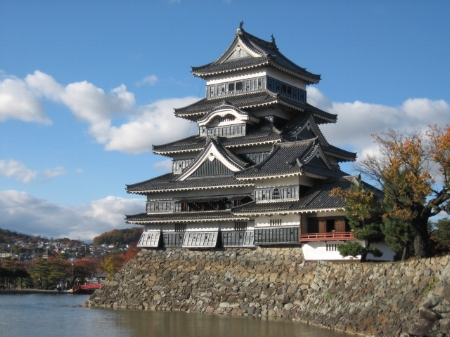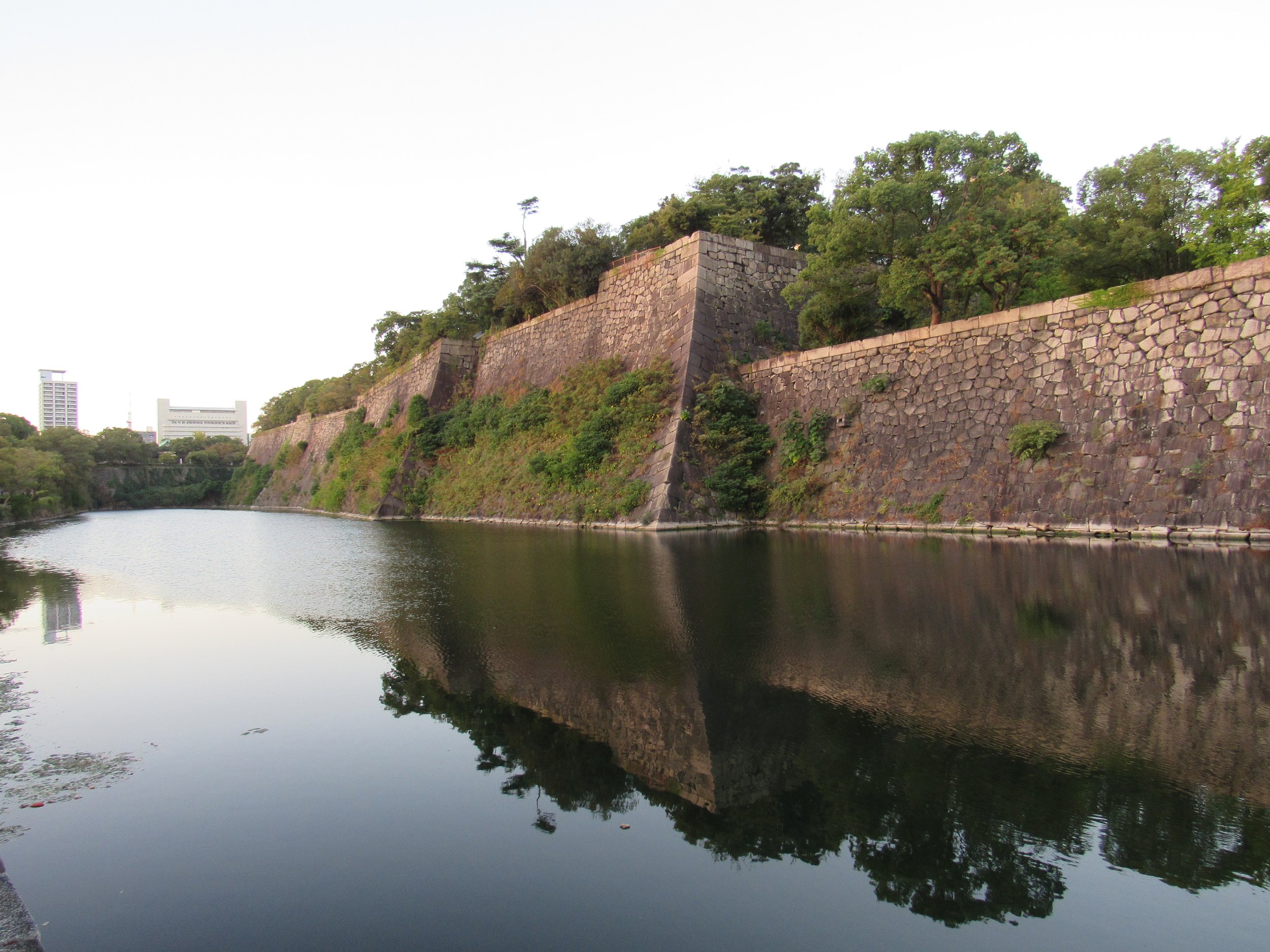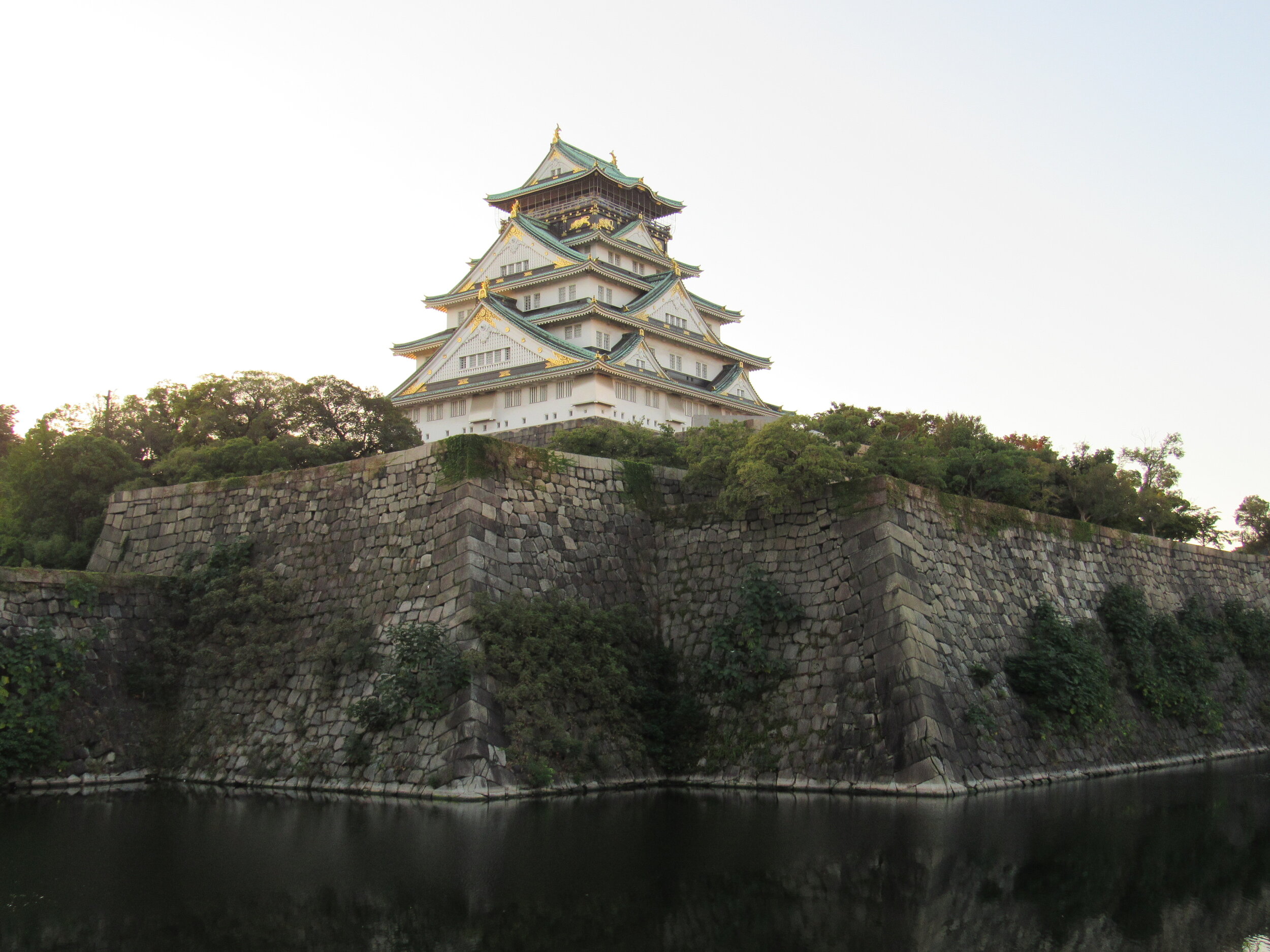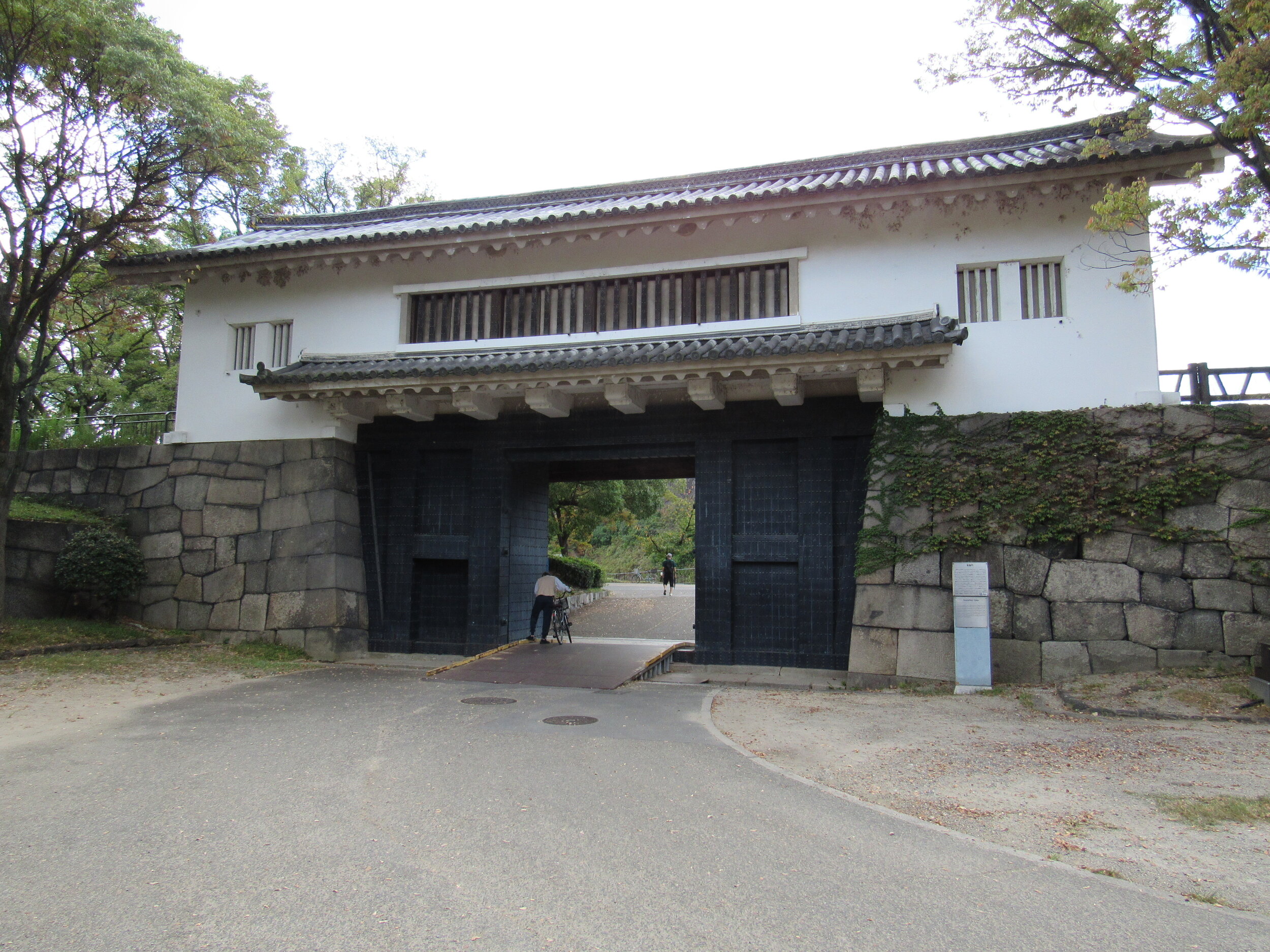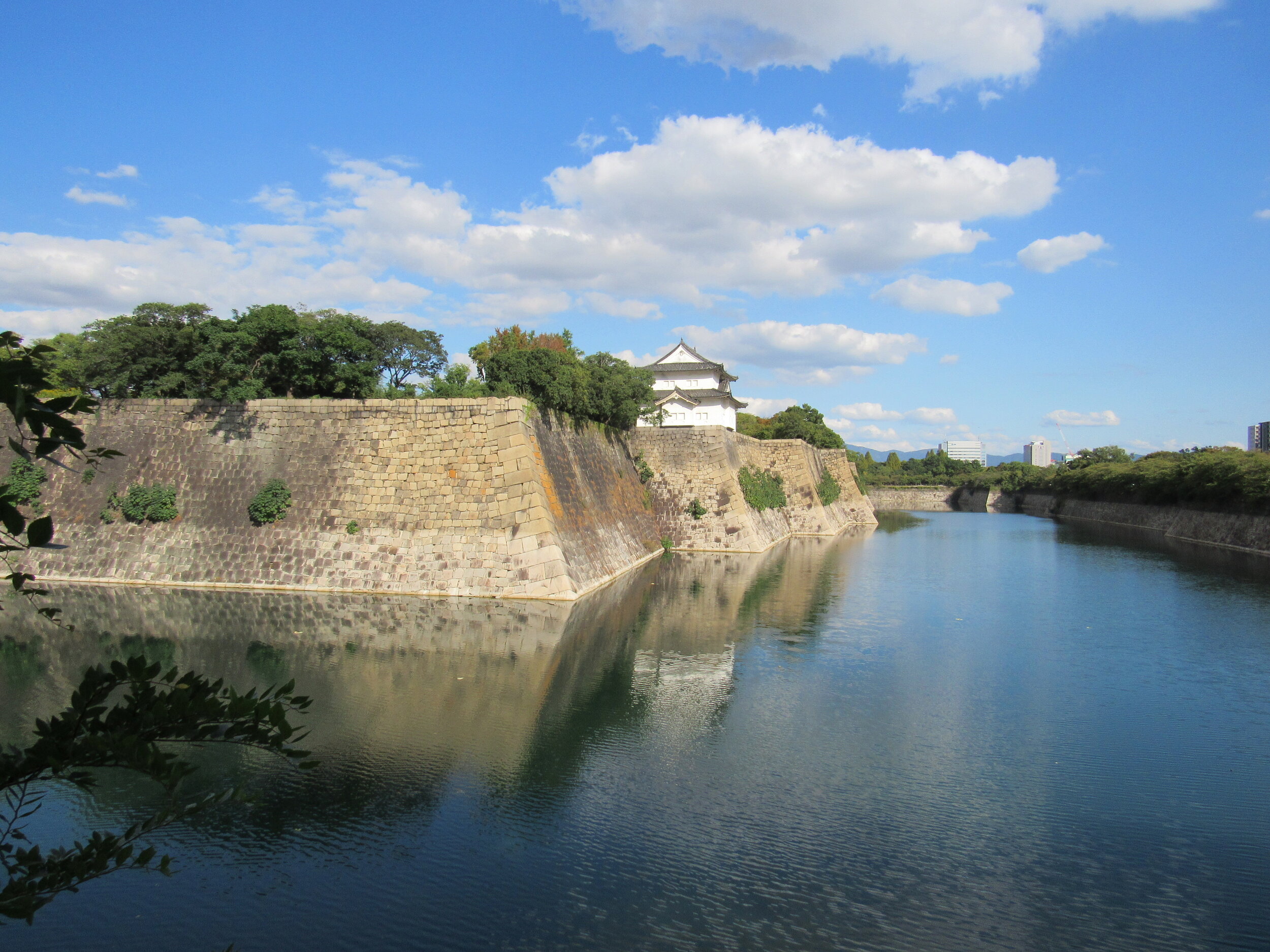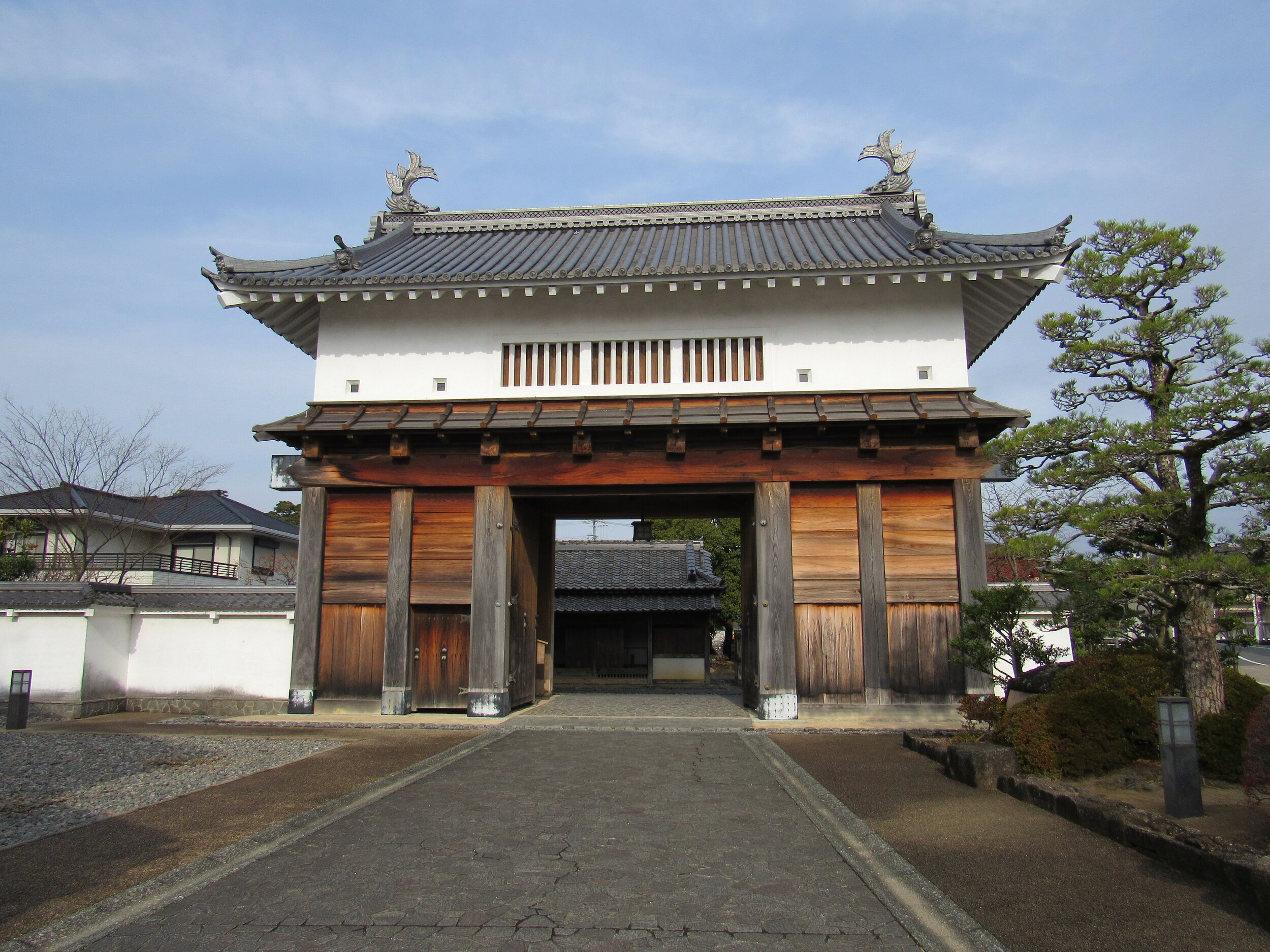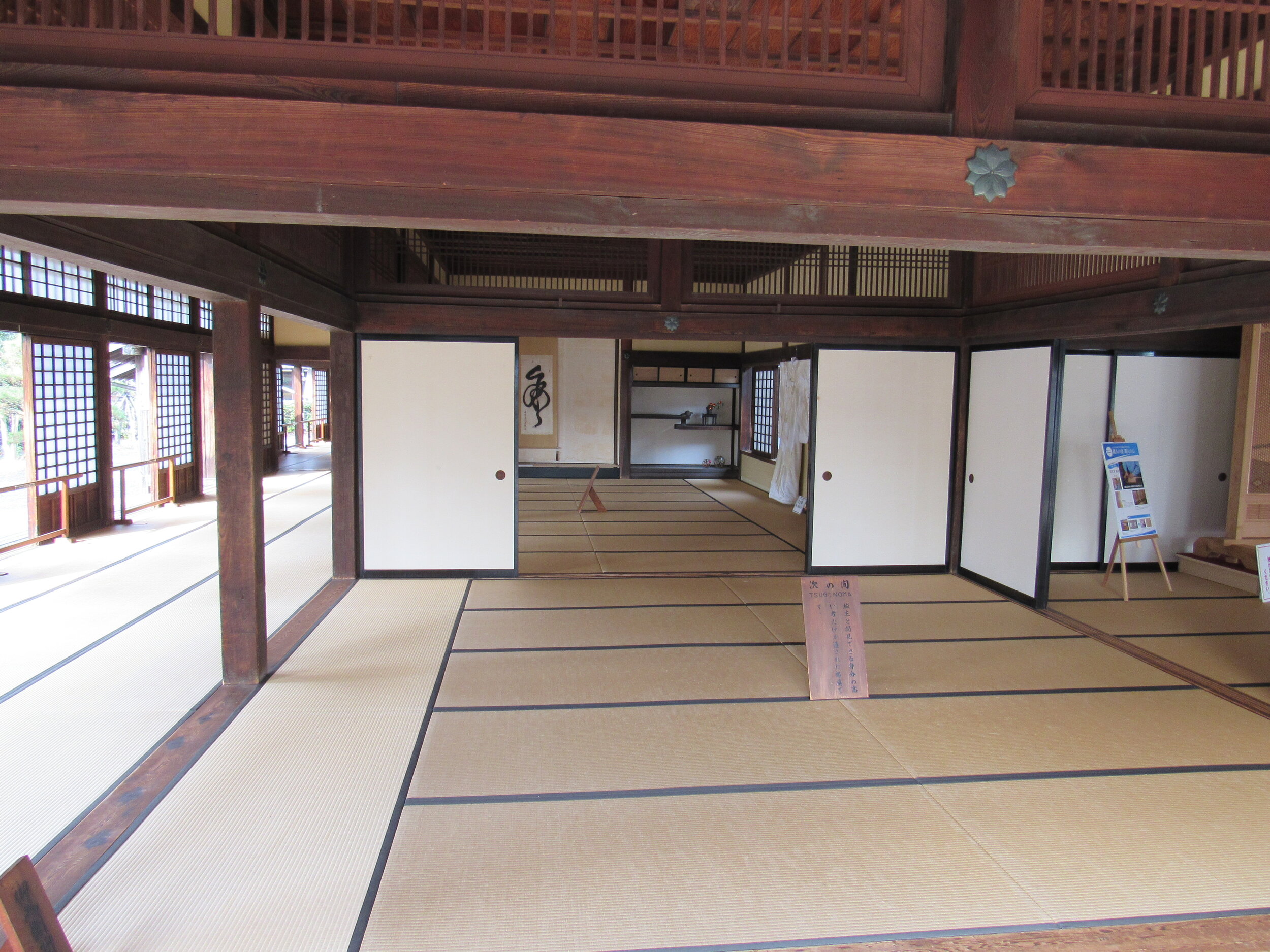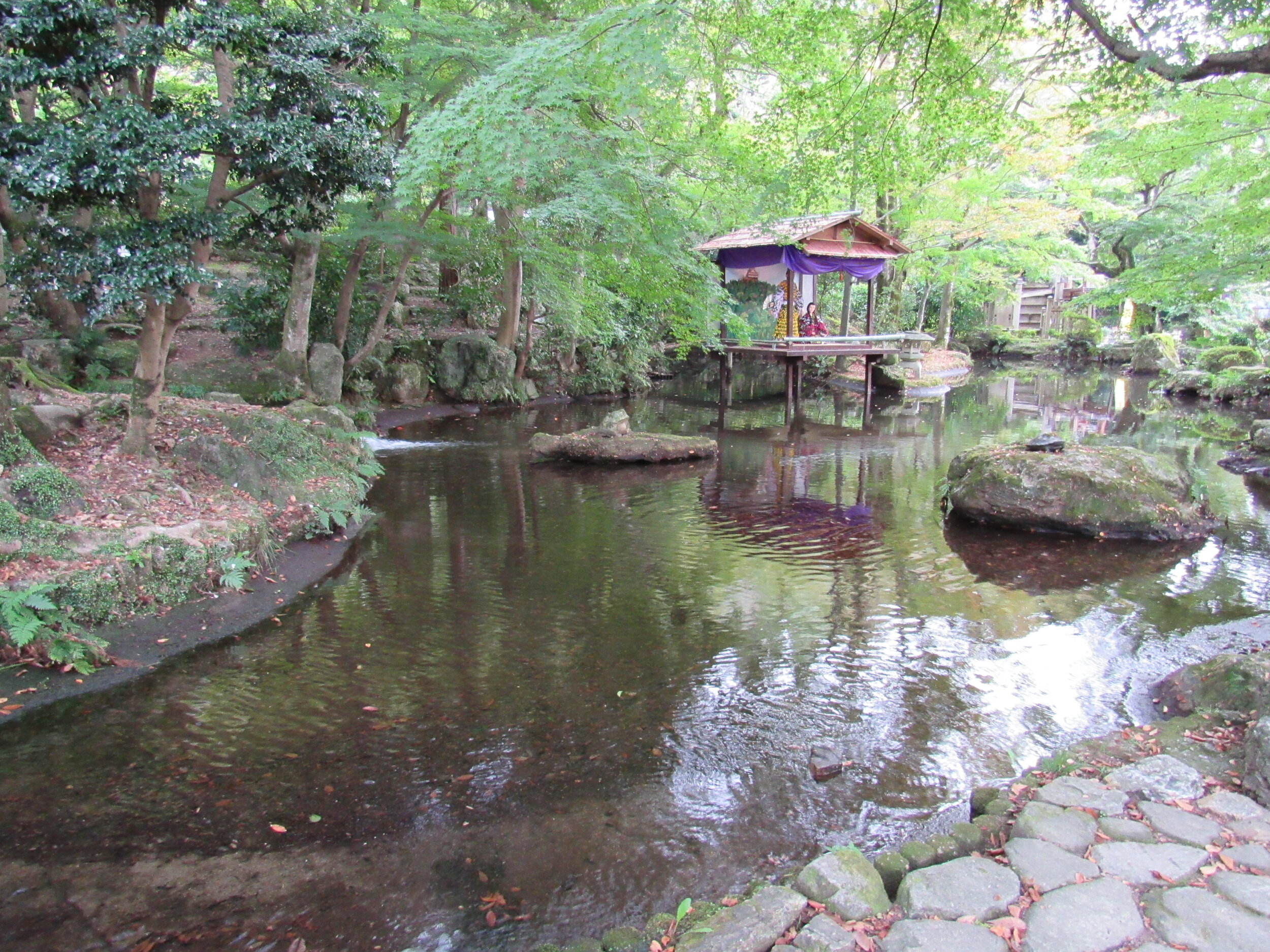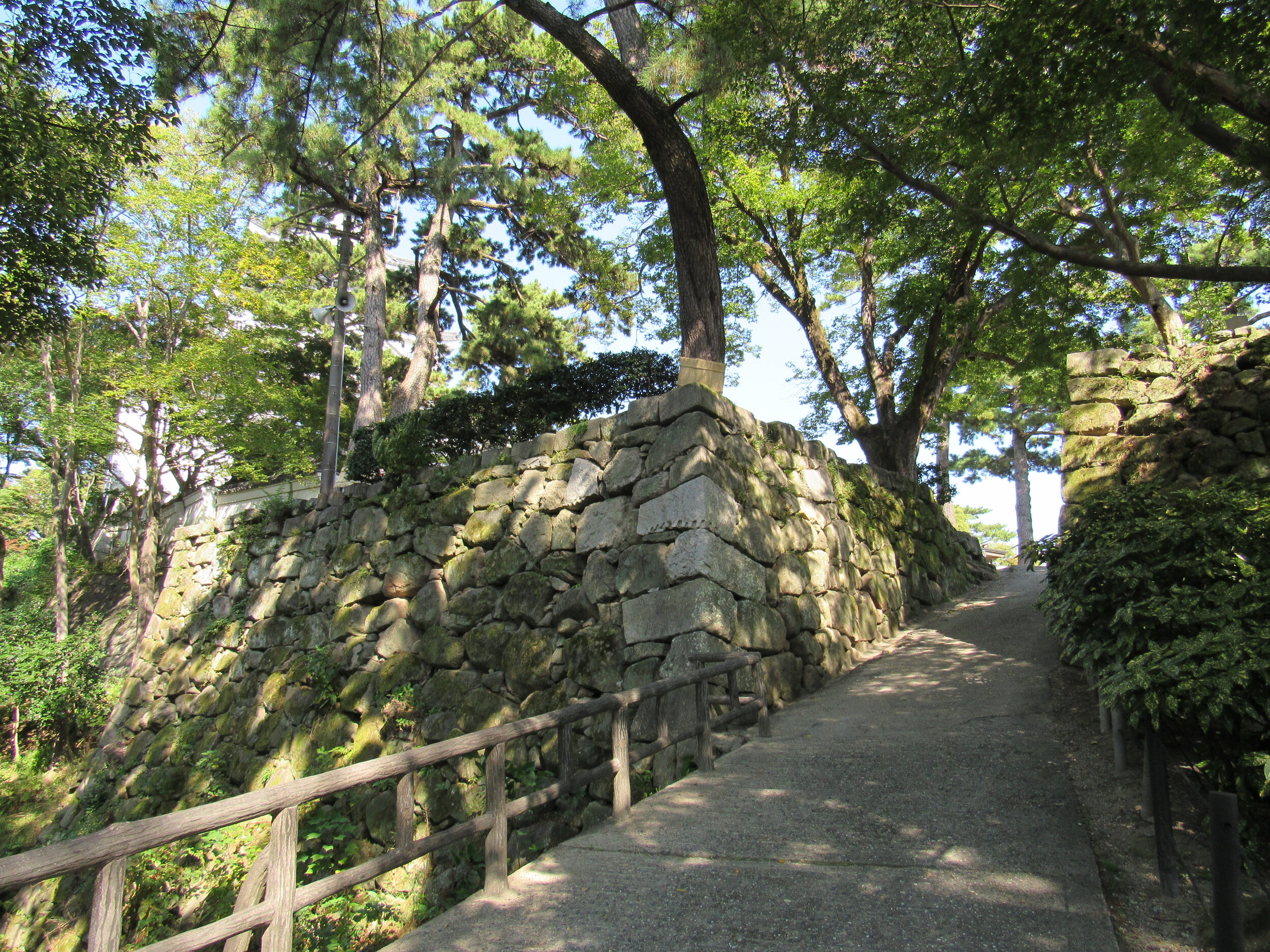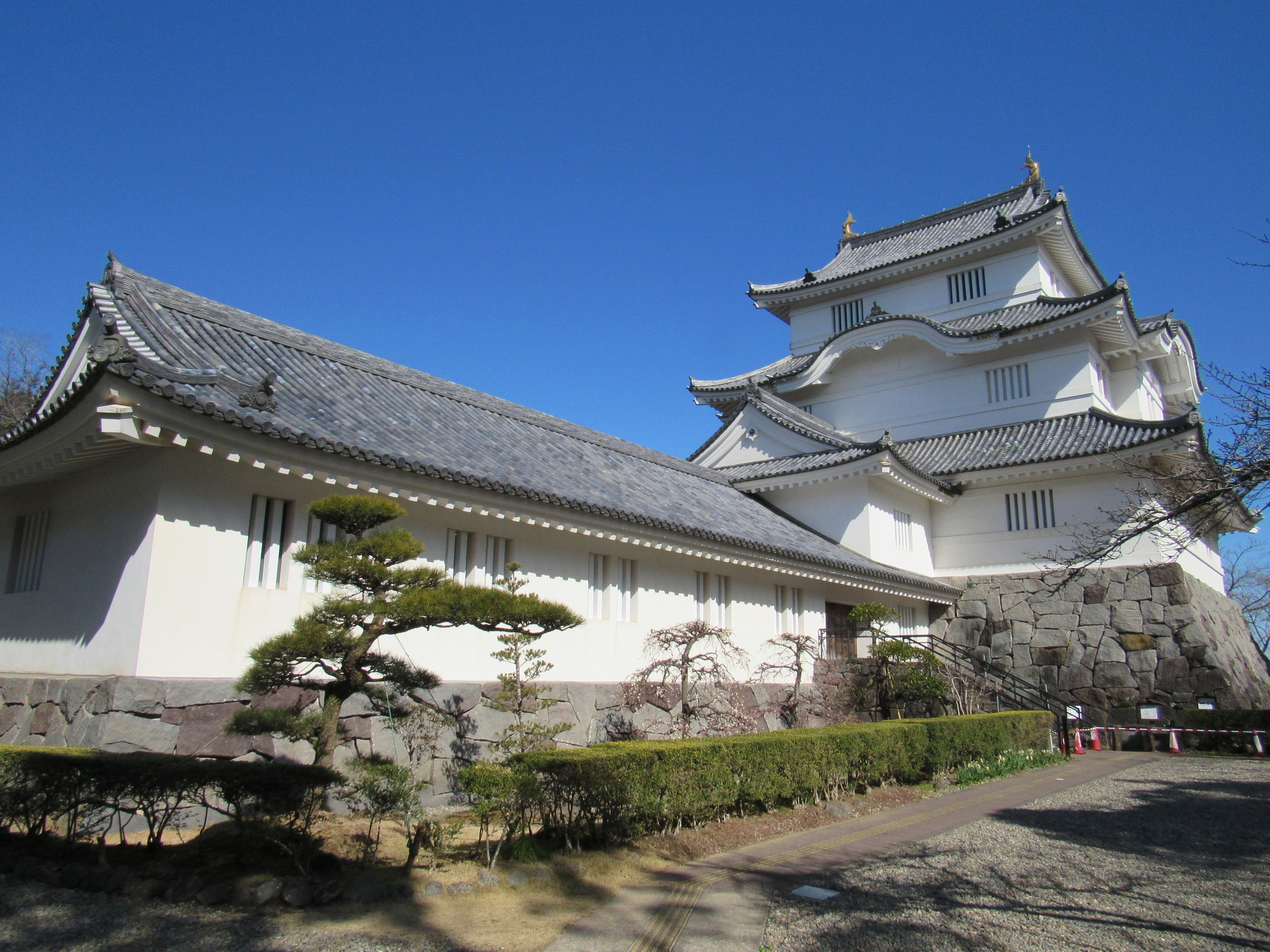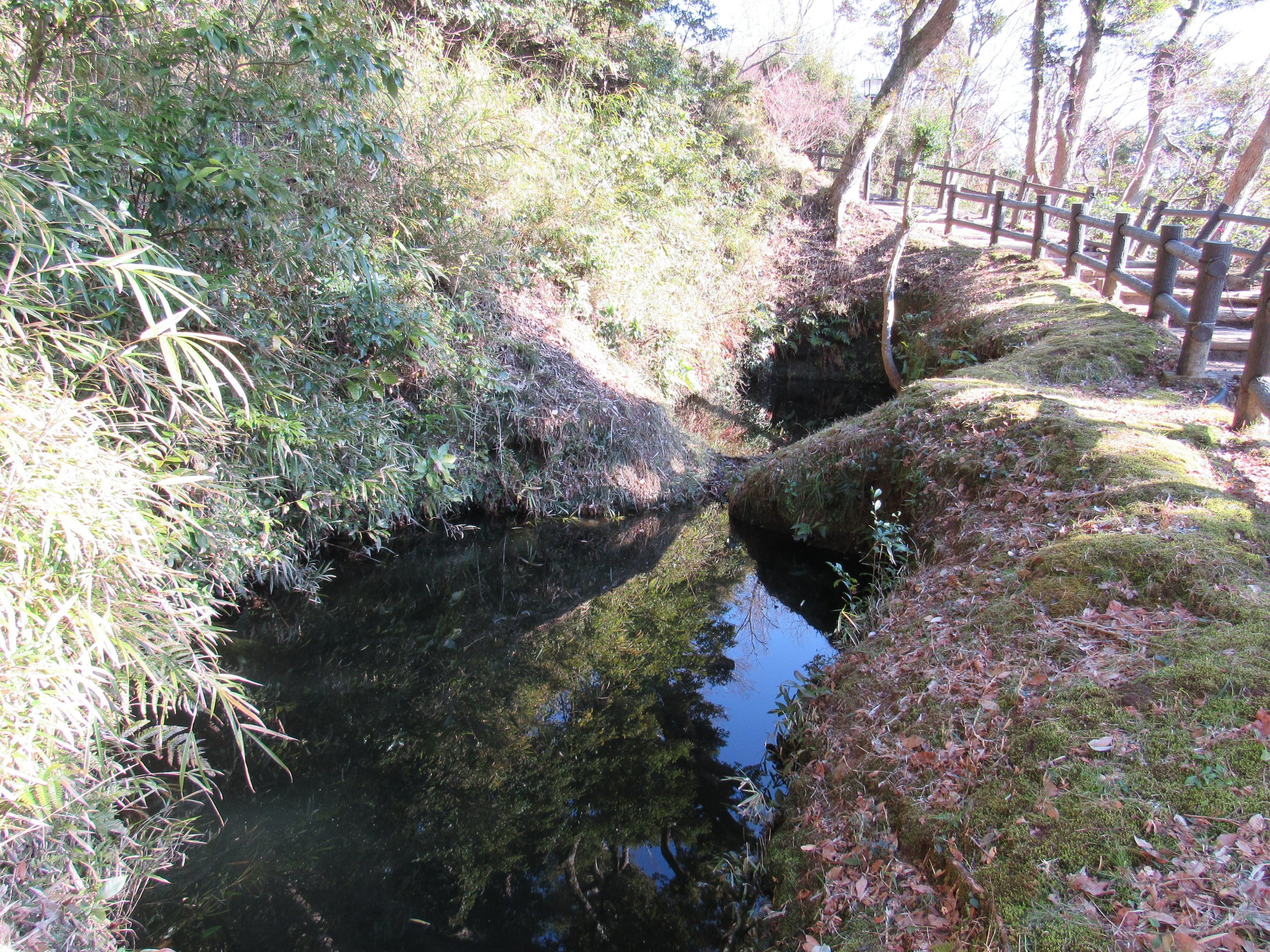(click on any picture to see it enlarged)
Japanese Castles
The beauty and elegance of Japanese fortifications…
One of the most iconic, recognizable images in all of Japanese culture is the graceful shape of the Japanese castle. The mountainous but fertile Japanese archipelago, broken up as it was for most of its history into a multitude of small domains, is liberally dotted with the remains of these great, defensive bastions. Yet the stone-clad, precision landscaping we know today was a later development of Japanese fortification. This form, so recognizably distinct from fortifications found elsewhere in the world, began like it did in Korea, with simple packed earth topped by a wooden palisade. The threat of Chinese invasion after the destruction of Baekjae in 665 AD led to the importation of masons from that fallen allied kingdom, men experienced in the construction of stone walls, resulting in what came to be the first “modern” Japanese castles near Dazaifu on the island of Kyushu, Ono and Kii Castles. Over time the obvious advantage to be found in stone, vice hard-packed earthen walls, became clear, though construction required extensive means and access to a large workforce. Japanese rulers poured money and resources into building the exquisite stone-walled castles we see today, perfecting the form by the time Ieyasu Tokugawa established the final Shogunate. Only twelve castles across Japan are considered “original” meaning not reconstructed in modern times—five of them are included in the gallery below.
(click on the pictures to enlarge)
1) Himeji Castle
Born with the construction of a hilltop fortification in 1333, the castle was built there in 1346. Himeji Castle is one of the largest, most-visited in Japan and featured in the 1980s mini-series Shogun, playing the unlikely role of Osaka Castle. One of Japan’s first UNESCO Heritage Sites, it is also one of the 12 remaining original castles.
View from the very top, the command post and best vantage point, looking out over the castle buildings and the modern city beyond.
2) Kumamoto Castle
Perhaps my favorite, Kumamoto Castle was built in its current form by Kato Kiyomasa, one of the leading figures in Hideyoshi’s invasions of Korea 1592-98. An incredibly beautiful and expansive fortification, Kumamoto Castle was gravely wounded by the 2016 earthquake there and will likely take two decades to repair. More on that later. In the meantime, I present to you Kumamoto Castle in all her pre-quake glory.
This photo helps give some idea of just how large a castle Kumamoto is. The outer baileys remain largely intact, and so the space preserved within the walls is simply massive.
A view from within the first bailey looking up at the double-tenshu that characterizes this elegant fortress.
3) Osaka Castle
One of the most awe-inspiring of Japan’s Sengoku Jidai castles, Osaka was built by none other than Toyotomi Hideyoshi himself, on the verge of his campaign to unite all Japan. As such, it all but screams “I’m important” and his dominance over the scattered daimyos shows in the wide moats, unnecessarily high walls, and gold-decorated tenshu. A truly beautiful sight, this castle was designed from the ground up to make a statement!
Here, Osaka Castle is pictured behind the Osakajo Hall, a massive sports complex. The Hall actually lies within the 2nd bailey of Osaka Castle, between the Daini Neya River but short of the impressive first moat. The layout of the current castle reflects reconstruction by the Tokugawa Shogunate in 1620 after Ieyasu destroyed much of Hideyoshi’s original fortress in the 1615 Siege of Osaka.
Besides the river itself, Osaka Castle is surrounded and protected by two rings of moats divided into five wet and one dry sections. The outer moat pictured above is spectacular and would have presented a serious obstacle to assault.
The width of the inner moat was similarly not an easy obstacle to overcome and the only realistic access would have been the two bridges leading into the honmaru or central bailey. Of course, the honmaru was situated within an incredibly high wall that allowed the tenshu to lord over the castle much like Hideyoshi would stand with regard to the many daimyo of Japan.
For all the grandeur and over-engineering of the rest of the castle, the gate complexes reflected basic military necessity, without even the gold adornments that make the tenshu so spectacular.
I should have stood next to this stone wall within what would have been the gate complex defending the Gokuraku Bridge. The large stones here are roughly as tall as a human. The largest such stones I’ve ever seen incorporated into a Japanese castle. At Osaka, they seem to be a dime a dozen!
The ramp leading up to the honmaru or inner bailey serves to highlight—if such was still necessary—the awesome size of the tenshu within. A gatehouse would have originally spanned the gap to control entry.
The honmaru and tenshu stand significantly higher than the rest of the castle and the inner moat pictured here.
Taken from the top of the tenshu, the command post. Looking out over the golden dolphin adornment on the roof, the view of the castle grounds and modern Osaka City beyond is quite impressive.
Given the late date of its construction, Osaka Castle reflects the ultimate development of the Japanese castle as an architectural artform, taking into account 900 years of lessons learned and technological progress. It certainly shows in the layout and general appearance of this fortress.
Osaka Castle might be one of the most beautifully lit of Japan’s many fortresses. Even against the backdrop of the Osaka skyline—or maybe because of it—it stands out in a way that’s magical. If you’re there, you almost can’t take your eyes off of it.
4) Matsumoto Castle
Another of Japan’s 12 original castles, Matsumoto has to be one of the most photogenic castles in all of Japan. The current form of this fortification dates to 1594, and it is most famous for the long, red bridge across the moat. Highly recommend visiting in the Autumn!
I’ve taken literally thousands of castle pictures here in Japan, but I think this one is my all-time favorite!
View from the command post looking down upon the moat and iconic red bridge. Seriously, Matsumoto in the Fall is a MUST!
5) Nagoya Castle
The last castle constructed during Tokugawa Ieyasu’s reign as shogun, Nagoya castle is a latecomer to the Japanese historical scene. Built in 1620 along the Tokkaido (East Sea Road), Nagoya Castle was intended to display the majesty of the Tokugawa family. While the castle and expansive grounds are certainly noteworthy, the palace within is absolutely spectacular and definitely worth a visit.
The walls of Nagoya Castle are high, impressive, and protected by a series of wide dry and wet moats. Given the late construction date—by Japanese standards—the masonry represents the full maturation of Japan’s castle-building as an art form.
Nagoya Castle burned down following Allied bombing raids in 1945, but several of the castle’s corner towers survived the aerial assault.
The opulence on display at Ninomaru Palace located—as the name implies—within the second bailey, is breathtaking and pictures really don’t do justice. The amount of gold, both metal and paint, on display here is incredible, and the morning light when we visited rendered superfluous all internal lighting. Comparable to Nijo Palace in Kyoto, with nightingale (squeaking alarm) floors to match, Ninomaru Palace was built when the Tokugawa were at the top of their game, and wanted everyone to know it.
Nagoya Castle Tenshu as seen from across the moat. The large golden dolphins atop the castle keep have become the symbols of Nagoya and show up everywhere around the city!
As with many Japanese “lowland” castles, Nagoya is lit up beautifully at night. We happened upon it on a night with no wind leaving the surface of the moat calm and reflective.
6) Matsuyama Castle
Another of Japan’s 12 original castles, and built in 1603, Matsuyama Castle wins my vote for the most defensible. Perched high atop a steep hill overlooking the city of the same name, the layout of the inner baileys of this castle is wonderfully diabolical. Situated on the west coast of oft-forgotten Shikoku Island, it is well worth taking the time to visit.
The lower baileys of Matsuyama Castle live up to their name . . . WAY lower than the inner two. This picture is taken from the outer (third) bailey. The stone work in the middle of the picture marks the second bailey. You can just make out the tops of the buildings of the first and main baileys above the tree line at the top of the hill.
Emphasizing the difference in height between the second and main baileys at Matsuyama. It really is THAT high!
Finally, the gate leading into the first bailey.
Looking down onto the first bailey from the command post atop the tenshu. The city of Matsuyama sprawls for miles in the background, but the castle stands above it all like a medieval stone guardian.
I love this design feature! The main entrance is a confusing and very defensible series of narrow, twisting turns passing through multiple smaller gates. The tenshu was also built in the shape of a hollow square, with the building’s entrance on the inside, making any approaching force have to brave the fire of the entire building’s worth of defenders . . . assuming they even made it that far!
Looking down into the second and third baileys from the command post. That far tree line marks the edge of the third bailey, and the beginning of the narrow moat that protects it.
7) Kochi Castle
Another of Shikoku’s hidden gems—and another of Japan’s 12 original castles—Kochi Castle is the archetype fortress of the era. Constructed in 1600 following the decisive Battle of Sekigahara, Kochi is laid out like a layer cake of concentric circles, each successive bailey looking down into the one below it. The addition of a false main gate adds to the defensibility of this particular fortification.
It was raining cats and dogs the only day we had to visit Kochi . . . so naturally, we went anyway. Apologies, however, for the quality of these pictures as they don’t do Kochi Castle justice.
The infamous false gate at Kochi Castle. Painted to look just like the real thing, it was designed to channel attackers into a kill-zone for archers positioned along the walls of the main bailey up above.
One of Kochi’s real gates.
Kochi Castle is fairly unique in that the castle lord’s domicile has been preserved within the main bailey.
View from Kochi Castle’s tenshu, looking down upon the false gate to the left and stairway leading to the main gate to the right.
8) Odawara Castle
Odawara Castle was originally built in 1477—then rebuilt in 1633 and 1706. A beautiful castle with significant defenses, the short red bridge and long, straight stairway into the tenshu are unmistakable features of this fortification. The siege of Odawara Castle in 1590 saw Hideyoshi strip the holding from the mighty Hojo family and award the castle to his best general, Tokugawa Ieyasu.
There’s a rare appreciation for beauty present in the layout of Odawara Castle. A lowland fortification, it’s surrounded by a photogenic moat system that weaves its way into, between, and around the various defensive constructs in a way most pleasing to the eye.
This shot through the doorway nicely illustrates the concentric rings of defenses characteristic of Japanese castle design. The massive doors in the foreground are separated from the gate complex just visible to the left by water in the protective moat, and the tenshu, or keep, in the center is further separated by a steep climb, protected by high stone walls.
Love this little bridge!!
The climb up to the inner bailey of Odawara Castle. Note the U-shaped defensive structure attached to the gatehouse at the top.
The main gate to the inner bailey at Odawara Castle. The 90-degree turn into the gate is characteristic of Japanese castles and was intended to maximize the effect of fire from archers and arquebusiers manning the gatehouse above, and the U-shaped defenses to the sides.
Expansive inner bailey, stone donjon, and tenshu keep of Odawara Castle.
9) Hikone Castle
Built just after the Tokugawa victory at Sekigahara, visitor pour into scenic Hikone Castle not for its historical significance—it has none—but for the beauty of its design. Built at the beginning of Japan’s long peace, the fortification was built to impress, and does so with some of the most elegant design features this traveler has yet found in military construction. Hikone was completed by Ii Naokatsu in 1603, and includes one of Japan’s 12 surviving original tenshu towers, beautifully preserved in every respect.
Like Osaka Castle, Hikone has a double moat. The outer moat is pictured above. The width of this moat makes clear it was for defensive purposes. The Ii Clan had no way of knowing the Tokugawa had ended Japan’s Warring States Period!
A Gate complex at the far end of the bridge would have limited access to the inner moat beyond.
The inner moat, however, is largely aesthetic, a gorgeous man-made river where the castle around it seems almost like an afterthought.
The main entryway to Hikone Castle is a long, massive stone ramp leading up to the next bailey. Pictures don’t really do it justice, as the sheer size and height are truly awe-inspiring!
I love this bridge too, featured in an impactful scene in the Shogun mini-series as a feature of “Osaka Castle” (played on screen by Himeji Castle!).
This unique gatehouse leading into the inner bailey of Hikone Castle has a “ground-level” access, allowing much faster manning in an emergency, a nifty innovation, and one I’ve rarely seen.
Looking out from the garden side of Hikone’s First Bailey, you can see the inner moat and wall in the right foreground, the town beyond—complete with Edo-style buildings—and the beautiful Lake Biwa in the background. Did I mention that Hikone was built for aesthetic purposes?
The original—and very well preserved—keep of Hikone Castle.
Not to be confused with concrete look-alikes, Hikone’s keep is all original. The preserved woodwork is exquisite!
10) Kakegawa Castle
Built by the Imagawa Clan in the mid-15th Century, Kakegawa Castle’s ownership was a virtual who’s who of late Sengoku Jidai personalities! This small, but extremely photogenic castle was owned by a retainer of Imagawa Yoshitada, Tokugawa Ieyasu, as well as Toyotomi Hideyoshi retainer Yamauchi Kazutoyo. The existing keep was destroyed twice by earthquake and rebuilt in 1621 and 1994, the latest effort faithfully observing the original methods of castle construction.
Besides the tenshu just visible across the river, Otemon (literally ‘Big Hand Gate’) is the first visual evidence a visitor gets of the medieval castle nearby.
The tenshu (keep) of Kakegawa Castle peeking out through the late Fall foliage.
Kakegawa Castle is a hirayamashiro, or elevated plains castle, standing watch over the medieval town of Kakegawa. The small hill upon which the tenshumaru (one of the few times I’ve seen this word) was constructed is easily the highest elevation in the fertile Sakasa River valley. The stairs leading up from the honmaru are winding and, in some places, fairly steep.
The final stretch of stairs leading up to the tenshu of Kakegawa Castle.
Kakegawa’s tenshumaru as seen from a window of the yashiki (palace) still standing within the castle’s second bailey (ninomaru). It really is a photogenic remnant of medieval architecture!
View from the top of Kakegawa Castle’s tenshu, down into the second bailey and the castle’s beautifully preserved yashiki, or palace. In later years, the palace served not only as the lord’s residence, but the rooms on the far side served as the police headquarters and other necessary administrative functions of local government.
The inside of Kakegawa Castle’s palace area. Much more plainly decorated than some of the more ornate yashiki we’ve visited, but to be honest, I think I like this better! As always, the wooden floors of living spaces are covered in rice straw tatami mats and the rooms separated by sliding wood-framed paper shoji doors.
Kakegawa Castle tenshu peeking out over the roof of the palace and foliage below.
11) Saga Castle
Of little renown, I all but tripped across this quaint Edo-era castle while researching other aspects of Kyushu’s history. Construction completed here in 1611 after receiving the permission of the Tokugawa Shogunate nine years prior. Most of the castle was destroyed by government forces after disgruntled samurai resisted Meiji-era modernization during the Saga Rebellion of 1874.
Fairly interesting main entrance to the stone donjon base, which would have supported the castle’s tenshu.
The Meiji Era prefectural building has been re-cast in the role of a museum. Saga families participated in some of the more significant events in Japanese history to include the invasions of Korea 1592-98 and the Meiji Restoration. This museum holds displays—to include a lot of original artwork—from those periods.
12) Uwajima Castle
Built in 1596 and another of Japan’s 12 original castles, Uwajima was another accidental find. Taking the less-traveled southwestern Shikoku train from Matsuyama to Kochi, a one-hour lay-over led to a mad dash up the hill to visit this beautiful little castle, just visible from the train station platform. Well worth it!
This was essentially all we could see from the train station. Looked at the time and decided we could get there and back in an hour. Just BARELY made the train, but it was worth the run.
As you can see from the ascending stone steps, Uwajima Castle gets few visitors these days.
Quite the imposing sight greets you as you reach the castle’s lower walls.
This picture, taken from the main bailey, shows why Uwajima Castle was built here, as it dominates the nearby harbor and town.
13) Inuyama castle
Originally built in 1440, and last modified in 1620, Inuyama Castle is another of Japan’s 12 original castles. Small, by comparison to many of it’s peers, the fortress was built onto an imposing terrain feature that rendered the need for additional stone defenses unnecessary. The diminutive yet still elegant tenshu overlooks the scenic Kiso River. Inuyama Castle experienced the height of its fame when none other than Oda Nubunaga himself, the first of Japan’s three great unifiers, seized the fortress in 1564, solidifying his hold over Owari Province.
It doesn’t show up so well in the picture, but this long alleyway actually falls between the walls of the second and third baileys and is fairly steep, leaving potential attackers at a distinct disadvantage as they progressed toward the main bailey and the castle’s tenshu or keep.
View from the top floor of the tenshu down into the main bailey of Inuyama Castle. Nonetheless, it shows the height above the surrounding buildings and landscape that made the location a site favored to build a shrine and then a castle.
The fortified gate leading into the main bailey at Inuyama Castle.
The small tenshu of Inuyama Castle in all its glory. Note the COVID screening station set up under the awning, an unfortunate development at all Japanese castles, it seems, in 2020.
It’s Inuyama Castle’s dominating perch above the Kiso River that marks the medieval structure at its most photogenic.
14) Gifu Castle
Originally constructed high atop Mt. Kinka in 1204 as Inabayama Castle, this represents another of the relatively small class of mountain castles which dot Japan’s many highland regions. Taken in a two-week siege by Oda Nobunaga in 1567, the great unifier saw the potential in the site and made it his headquarters, renaming the fortress Gifu Castle. The Oda version, however, featured extended fortifications and an opulent palace near the base of the imposing mountain and a series of fortresses nearby to barrack his large army, concentrating his forces there and negating the need to waste time calling up troops in time of need, granting him a significant advantage over other Daimyo of the time.
Make no mistake, Gifu Castle is way up there! Without the cable car, the hike alone—up and down the steep slopes—would have taken half the day. What an incredible place to build a castle!
Gifu Castle is small, and seems to teeter precariously atop Mt. Kinka, yet maintains a few charming points that stand out, to include this bridge over an intentional cut in the rock below the castle walls. The cut and bridge were intended to cannalize attackers and then, should it become necessary, provide a means to remove the spanning bridge, usually by burning. It would have had the (permanent) effect of raising the drawbridge in a European castle.
What no doubt captured Oda Nobunaga’s attention at Gifu is the view … you can see forever—in all directions—up there!
Gifu Castle under the Oda Clan became famous for its extravagance and display of wealth. The golden accents to this remote, mountaintop tenshu are remarkable and, set against the natural beauty all around, quite striking.
Down at the base of Mt. Kinka, nothing really remains of the palace and castle grounds except a beautiful Chinese style garden. The irrigation system, coming down off the mountain, was originally designed to feed the water elements of the palace grounds, and the old stone stairs visible here remind visitors of that ancient intent, providing the slightest hint at the beauty this site once conveyed to the many foreign dignitaries who visited Gifu Castle.
15) Okazaki Castle
Another diminutive castle, constructed in 1524, it may not have survived the ravages of time and faddish human interest had it not been for one very important fact. This was the 1542 birthplace of Tokugawa Ieyasu, Japan’s third and final great unifier and founder of the Tokugawa Shogunate, the last of Japan’s military governments. That said, there are a couple distinctive features worth pointing out—besides just visiting the birthplace of such an august and important individual in Japanese history.
The moat at Okazaki Castle is fed by the nearby sea and so experiences high and low tides. At low tide, however, the moat becomes a soupy morass.
The bridge across the moat leading to the second bailey is quite attractive and representative of the time period.
The castle parking lot exists within what would have been the original outer bailey and the field you see here would have been used to marshal and train the army. The stone stairs to the left here and the long white wall are all that remains of the third bailey’s defenses. Note: Okazaki is NOT a big city … for some reason the apartment building behind this corner of the castle is perhaps the tallest structure in the town. Go figure!
The only extant gatehouse at Okazaki. Much of Okazaki Castle was rebuilt in 1959 having been demolished in 1873 in accordance with Meiji Government ordinances related to castles—always potential rallying points for disaffected citizens inclined to rebel against increasingly strong central authority.
The rounded walls facing the main bailey at Okazaki Castle are virtually unique in Japan, and were designed by a Buddhist monk from the Saigo Clan who was the castle’s architect.
The tower here overlooks the moat and is the only remaining tower at Okazaki Castle.
The foliage has been allowed to grow quite close to the tenshu at Okazaki Castle, making it somewhat difficult to get good pictures of the small keep. Though the time of day of our visit didn’t help either as the best spot (above) turned out to have just a bit too much light to truly appreciate the castle.
The approach to Okazaki Castle’s main gate.
For such a small castle, the inner pathways and support buildings were a complete maze and would have been intensely confusing for any attacking force. Only a small portion of the reconstructed support buildings remain today, but every indication is that the type of compound pictured above crowded much of the second and third baileys at Okazaki.
Not a great picture of the tenshu at Okazaki Castle, but the best I could do under the circumstance.
16) Tsuruga Castle
Built by Naomori Ashina in 1384, Tsuruga Castle is a beautiful remnant of Medieval, Tohoku, Japan. Destroyed by government forces during the Boshin War, the current keep and attached buildings were rebuilt in 1965, following as closely as possible to the original design.
18) Inohana (Chiba) Castle
Built by the Chiba Clan in 1126, this diminutive site in the middle of downtown Chiba City, remained in use until the clan’s defeat in 1455. Easily accessible, only the reconstructed keep remains. Situated on a small promontory in the otherwise flatland of northwestern Chiba Peninsula, it would have provided protection and a center of government for a population perched between the highlands to the south, the warlike clans to the north, and the massively productive Kanto Plain to the west.
19) Otaki Castle
Scenic Otaki Castle, in southern Chiba, rides the backbone of highland that gives the peninsula, forming one side of Tokyo Bay, its shape. Original construction took place early in the 1500s by the Satomi Clan on a promontory overlooking a wide valley, but fell into disuse near the end of the century. Following Ieyasu Tokugawa’s relocation to the Kanto Plain, he ordered one of his most renowned generals, Honda Tadakatsu, to rebuild the fortification at Otaki in 1590. Honda’s descendants would rule Otaki for the next four generations, even marrying into the ruling Tokugawa Clan. The castle itself is uniquely situated atop steep bluffs on all sides, making any approach difficult at best. Today, only the keep remains, yet perched over the municipality of Otaki like a guardian, it’s easy to imagine the security this stronghold projected to the farmers and townspeople in the expansive valley below.
The yawning well of Otaki Castle lies well below the level of the central keep in what would have been either the 2nd or 3rd bailey. Only the keep remains today, none of the bailey walls, but this well and one small gate have been preserved in the shadow of the extant castle.
20) Kururi (Ujo) Castle
Constructed in 1456 by the Kuroda Clan, even amongst the steep hills of southern Chiba Prefecture, one would have to search pretty hard to find a less accessible location! It’s a long (steep) walk to reach the keep of this castle, all the while realizing that 700 years ago that entire climb would have been within the walls of the long, slender castle. That said, only the reconstructed keep remains today, though there is a nice museum within the 2nd Bailey. As with other Chiba castles, the site offers majestic views of the surrounding highland as well as a beautiful panoramic view of the narrow valley and town of Kururi.
This path approaches the juncture where the 2nd Bailey would have met the Central Bailey and heads down to the valley floor.
This male and female well—it appears to be a name only and not indicative of any segregation of drinking water—is nearly two meters deep. It lies along the steep path leading from the 2nd Bailey to the keep and is fed by underground springs.
21) Tateyama Castle
This charming, reconstructed keep was originally built in 1580 on a bluff overlooking the sea. From the keep one can gaze northward toward Tokyo, that modern view obstructed by a promontory just to the north. But the dominant view—and what no doubt inspired construction 442 years ago—is the vision of distant Mt. Fuji, looming over the intervening terrain and bay like an ancient dragon. Only the keep remains, high above the local municipality, but it doesn’t take long at all to see why the castle was built where it was!
This is the view from Tateyama Castle north toward Tokyo, none of which is visible despite its proximity.
Ignore the military base in the foreground, this is the view to the west from Tateyama Castle…even on a hazy day. I can only imagine what it must look like on a clear one!
